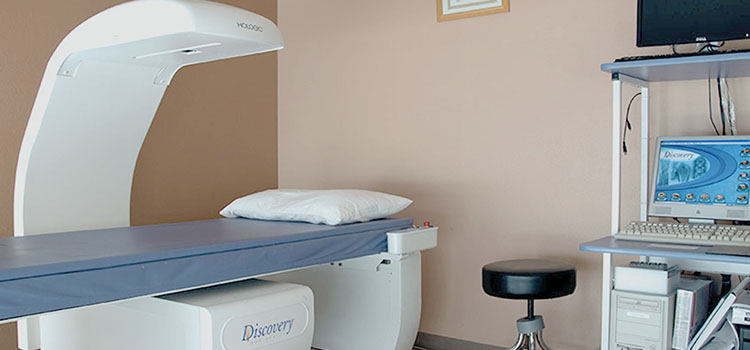Bone Densitometry (DEXA)

Bone Density is measured using Dual-Energy X-ray Absorptiometry, or DEXA (DXA). A DEXA scanner produces two X-ray beams, each with different energy levels. We analyse the number of X-rays that pass through the bone for each beam. The difference between the two beams dictates the bone density.
The information gained can be used to estimate bone strength and the likelihood of fracture or breakage. The amount of radiation exposure during DEXA is low, so the procedure is extremely safe.
What is a DEXA bone density scan?
Dual-energy X-ray absorptiometry (DEXA) is an imaging tool that uses a very low dose of X-ray energy to detect the presence of osteoporosis.
Women begin losing their bone density in their late 30s and 40s. After menopause, bone density loss speeds up due to hormonal changes – up to 20% of bone mass can be lost in the 5 to 7 years following menopause – making women more at risk for fractures to the spine, hips and wrists. Osteoporosis is also called the silent disease, as it rarely shows symptoms until there is a significant loss of bone mass. The most visible signs may be loss of height and curvature of the upper spine and back area. Osteoporosis affects an estimated 22 million Americans – 80% of whom are women.
Certified bone densitometry radiographer conducts bone density tests, and they take approximately 15 minutes to perform. DEXA scanning can highlight low bone density in patients at an early stage, allowing doctors to prescribe appropriate treatment and halt the progression of further bone density loss. Once our patient is positioned properly on the scanning table, our radiographer activates the scanner to analyse the bone mineral density of the hip and spine.
The machine then calculates two test scores: a T-score, which compares the patient’s bone density to that of a healthy 30-year-old woman, and a Z-score, which compares the patient’s bone density to the normal rate for a woman of the same age and body size.
The machine also captures X-ray images of the patient’s hip and spine, which a radiologist interprets. Exam results are reported directly to the patient’s physician within 24 hours.
The National Osteoporosis Foundation recommends that women get regular bone density tests beginning at age 65. However, numerous risk factors related to personal and family history, lifestyle, and ethnic background put some women at higher risk for the disease. Many physicians often recommend beginning DEXA scans at the age of 50 and advise patients to schedule them with your annual mammogram.
What do the results mean?
DEXA exams compare your bone mineral density (BMD) to that of a healthy 30-year-old woman – and a Z-score, which compares the patient’s bone density to what is considered normal for a woman of the same age and body size. This information, along with other factors, helps doctors make an accurate diagnosis.
These T-scores define the amount of bone loss: Normal: T-score above -1 Osteopenia (low bone density): T-score between -1 and -2.5 Osteoporosis: T-score below -2.5
These test results, combined with other factors, will give your doctor an accurate idea of your risk of fracture, which is important as there are many ways to prevent osteoporosis and to reduce fracture risks. After reviewing your DEXA Scan results, your doctor may suggest several steps important in building bone strength. Suggestions may include exercise, changes in diet, hormone therapy, or other medicines known to improve bone strength.
How do I prepare for the exam?
Do not take any calcium supplements or medication on the morning of your exam. Try to wear comfortable clothing without metal fasteners or in the abdominal and pelvic area.
We will provide a gown if you do not have clothing without metal components. We may ask you to remove jewellery, eyeglasses and any objects or clothing that might interfere with the x-ray.
If you recently had a barium procedure -such as a barium enema, an upper gastrointestinal (UGI) tract exam, or computed tomography (CT) scan -you should wait at least 14 days before having a DEXA exam. The waiting period is vital, as residual barium may interfere with your DEXA results.
Please also let us know before your exam begins if you may be pregnant.
